We use cookies to provide our clients with the best possible experience. If You continue to use this site, you agree with our cookie policy. Read more »
- Academic Guidance
- Essay Examples
- Essay Topics
- How To Write
- Other Articles
- Research and Sources
- Synonym Explorations
- Writing Tips

Comprehensive Analysis of ‘To Kill a Mockingbird’: Themes, Characters, and Symbolism

“To Kill a Mockingbird” is a seminal work in American literature, written by Harper Lee and first published in 1960. The novel is set in the 1930s in the fictional town of Maycomb, Alabama, and is narrated by Scout Finch, a young girl whose father, Atticus Finch, is a lawyer defending a black man unjustly accused of raping a white woman. Through Scout’s eyes, the novel explores profound themes of racial injustice, moral growth, and the loss of innocence. “To Kill a Mockingbird” won the Pulitzer Prize and has since become a classic, widely taught in schools and revered for its exploration of deep social issues.
The purpose of this summary is to provide a concise yet comprehensive overview of the novel, capturing its essence while ensuring that readers understand the key themes, characters, and plot elements. Given the novel’s complexity and the depth of its social commentary, this summary aims to highlight the most critical aspects of the story and its moral lessons. Understanding the context, motivations of the characters, and the overarching themes is essential for fully appreciating the novel’s impact on both literature and society.
Setting and Context
Maycomb, alabama.
The novel is set in the small, fictional town of Maycomb, Alabama, during the 1930s. Maycomb is portrayed as a quiet, close-knit community where everyone knows each other, but it is also steeped in prejudice and tradition. The town’s slow-paced, somewhat stagnant way of life reflects the broader socio-economic conditions of the time, where change is resisted, and societal norms are rigidly upheld. The dusty streets, old buildings, and the sense of a community bound by long-standing customs create an atmosphere that is both familiar and oppressive, making it a fitting backdrop for the novel’s exploration of racism and social injustice.
Historical Context
The story unfolds during the Great Depression, a period of severe economic hardship in the United States. This historical context is crucial, as it adds layers to the social dynamics in Maycomb. Poverty is widespread, affecting both black and white communities, though the burdens of racial inequality exacerbate the struggles of the town’s black residents. The novel also takes place at a time when racial tensions were particularly heightened in the American South, where Jim Crow laws enforced racial segregation and discrimination against African Americans was institutionalized.
Socio-Economic Environment
Maycomb is characterized by clear class divisions and a rigid social hierarchy. At the top are families like the Finches, who, despite not being wealthy, are respected due to their social standing and education. Below them are the poorer white families, such as the Cunninghams, who struggle financially but still retain a sense of pride. At the bottom of the social ladder are the black residents, who face systemic racism and are marginalized in every aspect of life. This hierarchy deeply influences the interactions between characters and drives much of the novel’s conflict. The economic disparities and social divisions in Maycomb are not just background details but pivotal elements that shape the story’s events and the characters’ motivations.
Main Characters
Scout finch.
Scout Finch, whose full name is Jean Louise Finch, serves as the narrator and protagonist of “To Kill a Mockingbird.” The novel is recounted from her perspective, providing a unique blend of childhood innocence and retrospective wisdom. Scout is six years old at the beginning of the story, and her youthful curiosity drives much of the narrative. She is a tomboy who prefers overalls to dresses and enjoys playing with her brother, Jem, and their friend, Dill.
Scout’s innocence and straightforwardness make her an engaging narrator, allowing readers to see the events of Maycomb through the unfiltered eyes of a child. As the novel progresses, Scout’s understanding of the complexities of human nature deepens. She begins to grapple with the harsh realities of racism, injustice, and moral ambiguity, particularly as she witnesses her father’s efforts to defend Tom Robinson. By the end of the novel, Scout has grown significantly, both in her understanding of the world and in her empathy for others, symbolizing the journey from innocence to a more nuanced moral awareness.
Atticus Finch
Atticus Finch is the moral backbone of the novel, embodying integrity, wisdom, and compassion. A lawyer by profession, Atticus is a widower raising Scout and Jem alone, and he is as much a mentor as he is a father. His parenting style is progressive for the time; he treats his children with respect, encourages them to think critically, and instills in them the values of empathy and justice. Atticus is perhaps best known for his advice to Scout that “you never really understand a person until you consider things from his point of view… until you climb into his skin and walk around in it.” This principle of empathy is central to Atticus’s character and serves as a moral compass throughout the novel.
Atticus’s defense of Tom Robinson is the central event that brings the novel’s themes of racism and justice to the forefront. Despite knowing that the odds are stacked against him due to the entrenched racial prejudices of the time, Atticus takes on Tom’s case because he believes in doing what is morally right, regardless of the consequences. His calm demeanor, rationality, and unwavering commitment to justice make him a role model not only for Scout and Jem but also for readers. Atticus’s character challenges the moral failings of society and serves as a beacon of integrity in a deeply flawed world.
Jem Finch, Scout’s older brother, undergoes significant character development throughout the novel. At the beginning of the story, Jem is a typical boy of ten who enjoys playing games, particularly those that involve imagining the mysterious life of Boo Radley. However, as the events of the novel unfold, particularly during and after the trial of Tom Robinson, Jem’s character begins to change.
Jem’s journey is marked by a growing awareness of the injustices that pervade the adult world. He is deeply affected by the trial and the guilty verdict, which shatters his idealistic belief in fairness and justice. This disillusionment is a pivotal moment in Jem’s development, as he transitions from the innocence of childhood to a more mature, though more painful, understanding of the world. Jem’s protective instincts towards Scout also grow stronger, and he starts to take on a more adult-like role in their relationship. By the end of the novel, Jem is on the cusp of adolescence, carrying the weight of the lessons learned during these formative years.
Tom Robinson
Tom Robinson is a black man who is falsely accused of raping Mayella Ewell, a white woman. His character is central to the novel’s exploration of racism and injustice in the American South. Tom is portrayed as a hardworking, compassionate individual who, despite the overwhelming prejudice against him, tries to help Mayella out of pity for her lonely and difficult life.
Tom’s trial becomes the focal point of the novel, revealing the deep-seated racism that permeates the legal system and the community of Maycomb. Despite compelling evidence that proves his innocence, the jury convicts Tom simply because of his race. Tom’s fate is a powerful indictment of the racial inequalities of the time, and his character serves to highlight the human cost of prejudice. Tom Robinson is one of the “mockingbirds” of the novel, an innocent who suffers because of the evil and hatred of others.
Arthur “Boo” Radley is one of the most mysterious and misunderstood characters in the novel. Initially, Boo is portrayed as a figure of local legend, a reclusive man who never leaves his house and is the subject of various rumors and ghost stories told by the children of Maycomb. To Scout, Jem, and Dill, Boo is a source of both fear and fascination, and they spend much of their time imagining what he might be like.
As the novel progresses, Boo’s true nature is gradually revealed, particularly through his subtle acts of kindness towards the Finch children, such as leaving gifts in the knothole of a tree and eventually saving Scout and Jem from an attack by Bob Ewell. Boo Radley emerges as a symbolic “mockingbird” figure, representing the themes of innocence and goodness. Despite being feared and misunderstood by the community, Boo is ultimately a compassionate and protective figure. His relationship with Scout culminates in a poignant moment of mutual understanding, as Scout finally sees the world from Boo’s perspective, fulfilling one of the novel’s central moral lessons.
Supporting Characters
Several supporting characters play crucial roles in the development of the novel’s themes and plot.
Calpurnia , the Finch family’s black housekeeper, serves as a maternal figure to Scout and Jem, bridging the gap between the black and white communities in Maycomb. She is a strong, moral presence in the Finch household, teaching the children about respect and equality.
Dill Harris , a close friend of Scout and Jem, represents childhood innocence and curiosity. His fascination with Boo Radley and his reaction to the injustices of the trial reflect the novel’s exploration of innocence and its loss.
Bob Ewell , the antagonist of the novel, embodies the worst aspects of racism and ignorance in Maycomb. His false accusation against Tom Robinson and subsequent actions drive much of the novel’s conflict, culminating in his attempt to harm Scout and Jem.
Mayella Ewell , Bob’s daughter, is a complex character trapped by her circumstances. Her actions, driven by fear and societal pressures, highlight the intersection of race, class, and gender in the novel.
Miss Maudie Atkinson , a neighbor of the Finches, serves as a voice of reason and moral support for Scout and Jem. She reinforces Atticus’s teachings and provides additional perspective on the events unfolding in Maycomb.
Plot Summary
Introduction to maycomb and the finch family.
The story of “To Kill a Mockingbird” is set in the sleepy town of Maycomb, Alabama, during the 1930s, a period marked by economic hardship and deep-seated racial tensions. The novel opens with an introduction to the Finch family—Atticus Finch, a lawyer and widower, and his two children, Scout (Jean Louise Finch) and her older brother, Jem. The Finch family lives in a modest home on the main residential street in Maycomb, where they are well-respected due to Atticus’s integrity and position as a lawyer.
Scout, the novel’s narrator, provides a vivid description of her early life in Maycomb. She is a curious and outspoken young girl who spends her days playing with Jem and their friend Dill, who visits Maycomb every summer. The children’s lives are relatively carefree, though their adventures often revolve around their fascination with the Radley house, a mysterious and dilapidated building down the street. The house is inhabited by the reclusive Boo Radley, a figure of local legend who never emerges and is the subject of wild rumors. Scout, Jem, and Dill are both terrified and intrigued by Boo, and they spend considerable time concocting plans to make him come out of his house.
The Incident and Trial
The central conflict of the novel arises when Tom Robinson, a black man, is accused of raping Mayella Ewell, a poor white woman. The accusation shocks the town of Maycomb, but it also brings to the surface the deep racial prejudices that permeate the community. Despite the overwhelming evidence pointing to Tom’s innocence, the case is tainted by the racist attitudes of the town’s white population.
Atticus Finch agrees to defend Tom Robinson, despite knowing that his decision will bring social ostracism and threats to himself and his family. Atticus is determined to provide Tom with a fair defense, embodying his principles of justice and equality. However, his decision to defend a black man accused of raping a white woman creates significant tension in Maycomb. Many townspeople turn against Atticus, viewing his defense of Tom as a betrayal of their ingrained social norms. The Finch family becomes a target of scorn, and Scout and Jem have to confront the ugliness of racism in their community firsthand.
Trial Proceedings
The trial of Tom Robinson is the pivotal event in the novel and serves as a powerful exploration of racial injustice. The courtroom scenes are intense, with Harper Lee meticulously detailing the proceedings. During the trial, Atticus presents a compelling case that exposes the inconsistencies in the testimonies of Mayella and her father, Bob Ewell. He demonstrates that Tom could not have committed the crime, given his physical incapacity due to a previous injury, and suggests that Mayella fabricated the story out of guilt and fear of her father.
Despite the clear evidence of Tom’s innocence, the all-white jury convicts him, underscoring the pervasive racism that overrides truth and justice in Maycomb. The trial is a turning point in the novel, not only because it seals Tom’s fate but also because it shatters the idealistic views that Scout and Jem hold about their community. Jem, in particular, is devastated by the verdict, as it contradicts his belief in the fairness of the legal system.
Verdict and Aftermath
The guilty verdict has profound effects on the characters, especially Scout and Jem. Jem becomes disillusioned with the world around him, struggling to reconcile the injustice he has witnessed with his belief in the goodness of people. Scout, while still grappling with the complexities of the situation, begins to understand the harsh realities of the society she lives in.
Tom Robinson’s fate is tragically sealed when he attempts to escape from the prison where he is being held and is shot dead by the guards. His death serves as a grim reminder of the dangers faced by black men in the South, even when they are innocent. The trial and its aftermath expose the deep flaws in the justice system and the moral failures of the community, themes that resonate throughout the novel.
Climax: The Attack
The novel reaches its climax when Bob Ewell, humiliated by the trial and seeking revenge, attacks Scout and Jem on their way home from a Halloween pageant. Bob’s attack is fueled by a desire to harm Atticus through his children, believing that this will restore his damaged pride. Jem is knocked unconscious, and Scout is trapped in her ham costume, unable to defend herself.
In a surprising turn of events, Boo Radley emerges from his house to save Scout and Jem. He intervenes just in time, killing Bob Ewell in the struggle and carrying the injured Jem back to safety. This act of courage reveals Boo’s true nature, contradicting the monstrous image the children had imagined. Boo Radley is finally humanized, and his actions underscore the novel’s theme of the “mockingbird”—an innocent being who brings only goodness to the world but suffers because of the evil around him.
In the aftermath of the attack, Scout reflects on the lessons she has learned throughout the novel. Her understanding of morality and justice has deepened, influenced by the events she has witnessed and the people she has come to know. Scout’s final interaction with Boo Radley is particularly poignant; she walks him home and, standing on his porch, sees the world from his perspective, just as Atticus had taught her to do.
Scout’s newfound empathy and understanding mark her growth from a naive child to a more morally aware individual. The novel concludes with Scout contemplating the events of the past year and the importance of protecting those who, like the mockingbird, are vulnerable and innocent. The story leaves readers with a powerful message about the importance of compassion, understanding, and the fight against injustice in all its forms.
Themes and Symbolism
Racial injustice.
“To Kill a Mockingbird” is a profound exploration of racial injustice in the American South during the 1930s. The novel portrays systemic racism as an ingrained and pervasive element of Southern society, manifesting in both overt actions and subtle social norms. Through the trial of Tom Robinson, Harper Lee vividly illustrates how deeply entrenched racism corrupts the legal system and social order. Tom, an innocent black man, is convicted not because of the evidence, but because of his race. The all-white jury’s decision reflects the societal belief in the inferiority of African Americans, and the trial becomes a symbol of the broader racial injustices that black individuals faced daily.
The novel goes beyond the courtroom to show how racism affects every aspect of life in Maycomb. From the casual use of racial slurs to the rigid segregation of black and white communities, the town’s social fabric is woven with discrimination and prejudice. Characters like Bob Ewell embody the basest aspects of this racism, while others, like Atticus Finch, stand as counterpoints, advocating for justice and equality. However, even Atticus’s best efforts cannot overcome the deep-seated racism that defines the town’s identity, highlighting the tragic and enduring nature of racial injustice.
Moral Growth and Empathy
One of the central themes of the novel is the moral growth of the characters, particularly Scout and Jem, as they navigate a world filled with complex ethical dilemmas. At the heart of this moral education is Atticus Finch, who teaches his children the importance of empathy and understanding others. He encourages Scout and Jem to “climb into another person’s skin and walk around in it,” a lesson that resonates throughout the novel as they encounter various forms of prejudice and cruelty.
Atticus himself exemplifies moral courage, taking on Tom Robinson’s defense despite knowing the personal and professional risks involved. His actions teach Scout and Jem that true courage is not about physical bravery, but about standing up for what is right, even when the odds are against you. Through their father’s example, the children learn to challenge societal norms and develop their own sense of right and wrong, marking their transition from innocence to a more mature understanding of the world’s complexities.
The Mockingbird Symbol
The mockingbird is one of the most significant symbols in the novel, representing innocence, goodness, and the unjust harm that can befall those who are vulnerable. The title itself, “To Kill a Mockingbird,” alludes to the idea that causing harm to those who do no wrong is a profound injustice. In the novel, Atticus explains that while it’s a sin to kill a mockingbird because they only bring beauty and joy into the world, it is also a sin to harm innocent people.
Tom Robinson and Boo Radley are the two primary “mockingbirds” of the story. Tom, despite his innocence, is destroyed by the evil and prejudice of society, while Boo, a reclusive figure misunderstood and feared by the town, ultimately reveals his kindness by saving Scout and Jem. The use of the mockingbird as a symbol underscores the novel’s critique of the senseless destruction of innocence by hatred and ignorance. It challenges readers to consider the moral responsibility of protecting those who are vulnerable and marginalized.
Social Class and Inequality
Social class and inequality are also central themes in “To Kill a Mockingbird,” explored through the interactions between different characters and the rigid social hierarchy of Maycomb. The town’s social structure is defined by both race and class, with wealthier white families like the Finches at the top, followed by poorer whites like the Cunninghams and the Ewells, and black families at the very bottom, regardless of their economic status.
The distinctions between these classes are highlighted through the characters’ interactions and the conflicts that arise from them. For example, the Cunninghams, though poor, are depicted as proud and honest, refusing charity and repaying debts in kind. In contrast, the Ewells are shown as morally corrupt, using their race to justify their mistreatment of others, despite their lower social standing.
The novel also explores how these class distinctions intersect with race, particularly in the way Mayella Ewell, a poor white woman, uses her position to falsely accuse Tom Robinson, knowing that her word as a white woman will be valued over his as a black man. This intersection of race and class exposes the complexities of social inequality in Maycomb and challenges the notion that justice is truly blind.
“To Kill a Mockingbird” is a novel that intricately weaves together powerful themes, compelling characters, and a gripping plot to deliver a poignant critique of racial injustice, moral growth, and social inequality. Through the eyes of Scout Finch, readers are introduced to a world where the innocence of childhood is confronted by the harsh realities of prejudice and hatred. The novel’s key characters—Scout, Jem, Atticus, Tom Robinson, and Boo Radley—each play crucial roles in unraveling the narrative, with their stories reflecting broader societal issues. The trial of Tom Robinson serves as the central event that exposes the systemic racism in Maycomb, while the symbolism of the mockingbird underscores the tragedy of harming the innocent. Through these elements, Harper Lee crafts a narrative that not only tells a compelling story but also challenges readers to reflect on their own moral beliefs and the society in which they live.
The enduring relevance of “To Kill a Mockingbird” lies in its ability to speak to universal themes of justice, empathy, and the fight against prejudice. Although the novel is set in the 1930s, its exploration of racial inequality and moral courage continues to resonate in today’s world, where issues of discrimination and social justice remain at the forefront of public discourse. Harper Lee’s portrayal of the complexities of human nature and the challenges of doing what is right in the face of overwhelming societal pressure is as pertinent now as it was when the novel was first published.
- Place an order
- About Writology
- How it Works
- Buy Custom Essays
- Nursing Writing Services
- Do My Assignment
- Buy a Letter of Recommendation
- Buy Research Papers

Everything You Need to Know About Analysing ‘To Kill a Mockingbird’ for English | Summary, Context, Themes & Characters

One of the classics of American literature, ‘ To Kill a Mockingbird’ has been assigned to you for your English class and you need to conduct an essay analysis. Whether you’re looking for a summary of the themes in To Kill a Mockingbird or a quick refresher of the key characters or context, we’ve got you!
You’ll also be able to download a copy of our analysed textual examples, as well as a sample paragraph so you can ace your tasks.
Let’s take a look together!
To Kill a Mockingbird Summary Key Characters in To Kill a Mockingbird Symbols in To Kill a Mockingbird Context Themes Explored in To Kill a Mockingbird Essay Analysis of To Kill a Mockingbird
Summary of To Kill a Mockingbird
To Kill a Mockingbird is a novel that centres around the Finch family and is told through the perspective of Jean (nicknamed Scout), within the town of Maycomb, Alabama. Atticus, Jean’s father, is a prominent lawyer and the family lives relatively comfortably despite the impacts of the Great Depression.

Image sourced from Wikimedia Commons
Scout, her brother Jem and their friend Dill spend the summer together where Dill eventually becomes fascinated by the Radley’s house where Boo Radley, a mysterious and ghostly figure that is the topic of much speculation and stories for the children of Maycomb .
Scout and Jem find gifts in the knothole of a tree on the Radley property, but Nathan Radley chases the children off the property and eventually seals up the knothole. When a fire breaks out, Jem tells Atticus that Boo is caused it.
Access the To Kill a Mockingbird Downloadable Sample Paragraph and Examples of Analysis
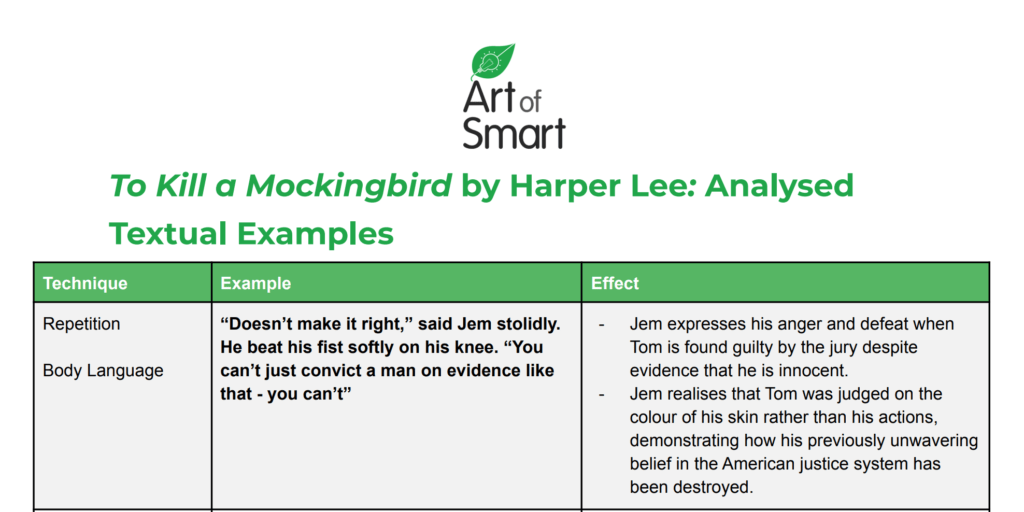
The climax of the novel arrives when Atticus agrees to defend Tom Robinson, a Black man who has been accused of raping a white woman. As a result, Scout and Jem get bullied by other children in their conservative, racist town.
At a pivotal moment, Mrs Dubose, the neighbour of the Finch family, harasses the children and Jem lashes out by destroying her garden.
As punishment, Atticus tells Jem to read to Mrs Dubose every day, explaining to the children that she is addicted to morphine and trying to overcome her addiction. Thus, despite the children’s initial indignation, Atticus teaches them an important lesson in empathy and perspective.
When Tom Robinson’s trial begins, he is held in the local courthouse where a group of people gather planning to lynch him. Atticus confronts the group the night before the trial, where Jem and Scout sneak out of the house to join him.
Recognising one of the men, Scout gently asks him how his son is doing, unknowingly shaming him and causing the group the disperse.
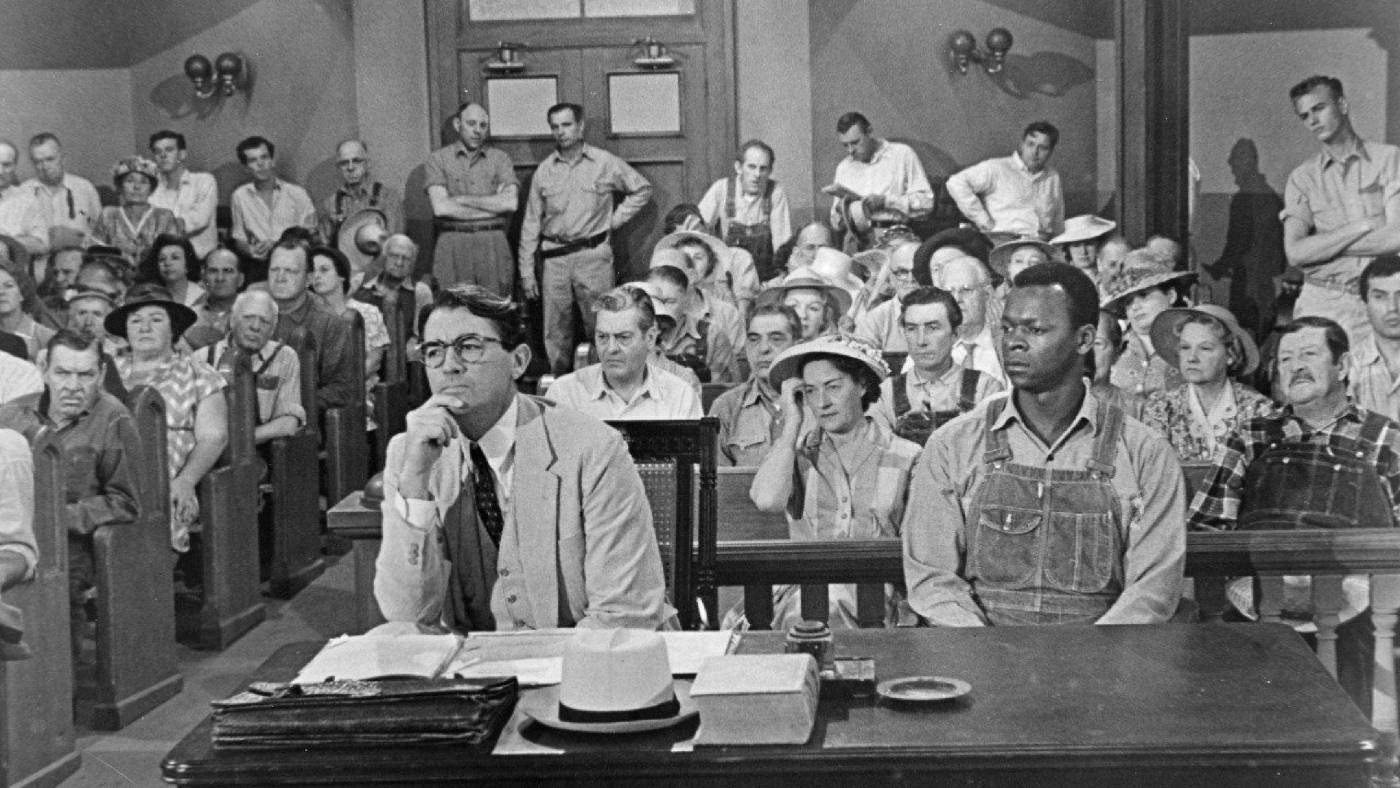
At the trial, the siblings choose to sit with the town’s Black citizens as Atticus presents clear evidence that Mayella and Bob Ewell are lying about the rape.
Atticus demonstrates that the injuries on Mayella’s face are wounds from Bob when he found her with Tom. However, despite the convincing evidence indicating Tom’s innocence, the all-white jury convicts him.
Tom is killed later on when he tries to escape prison. Additionally, despite his success at the trial, Bob Ewell feels that he has been made a fool and takes revenge.
First, he harasses Tom’s widow before finally attacking Jem and Scout as they walk home from a party. However, the children are saved by Boo Radley who fatally stabs Ewell during the struggle.
Boo carries an injured Jem home and Atticus insists that Ewell tripped over a tree root and fell on his knife to protect Boo. The novel ends with Scout walking Boo home and reflecting on the events of the novel and the complexities of humanity.
Key Characters in To Kill a Mockingbird
Jean Louise ‘Scout’ Finch Jean Louise ‘Scout’ Finch is the main character and we first met her when she is 6 years old, although it is narrated by an older Scout who is reflecting and looking back on her life. Through her, we learn about the town, her family and what it was like to live in the early 1930s during the Great Depression and the racial tensions that existed during that time.
Atticus Finch Atticus Finch is a single father in To Kill a Mockingbird who is appointed as the defence lawyer for a Black man who is accused of raping a White woman. Throughout the novel, Atticus teaches the children about empathy and how to view situations from different people’s perspectives instead of judging them harshly.
Jem Finch Jem Finch is Scout’s older brother who looks up to their father a lot. As an older brother, Jem accompanies Scout for a lot of her adventures and it is evident that the two are close. Being older, we watch Jem mature and often understand issues that Scout still does not.
Tom Robinson Tom Robinson is the Black man who Atticus defends during the rape trial. During the trial, there is compelling evidence that Tom is innocent and that the Ewells falsely accused him of rape. Despite this, Tom Robinson is found guilty due to the jury’s racial prejudice.
Boo Radley Arthur ‘Boo’ Radley is the Finch’s mysterious neighbour which the children in the town often speculate and make up scary stories about him. While he was a teenager, Boo was part of a gang of boys who caused trouble in Maycomb by drinking and gambling. As a result of this, he was locked in his home for many years and not allowed out. However, he has a soft spot for the children, leaving them gifts in the knothole of a tree and saving Jem when he is attacked by Bob Ewell.
Symbols in To Kill a Mockingbird
Mockingbird In “To Kill a Mockingbird,” the symbolic significance of the mockingbird resonates deeply. It represents innocence and goodness . Atticus Finch’s advice to his children, Scout and Jem, to never harm a mockingbird metaphorically extends beyond the bird itself. The innocent characters like Tom Robinson and Boo Radley are likened to mockingbirds, as they bring no harm but are subjected to cruelty and injustice due to societal prejudices .
The Radley Place The ominous Radley house and its reclusive occupants, particularly Boo Radley, symbolise the fear of the unknown . The town’s gossip and myths surrounding the Radleys serve as a reflection of the community’s prejudiced attitudes. Boo Radley, initially feared and misunderstood, eventually becomes a symbol of compassion and kindness, challenging the town’s preconceived notions.
These symbols intricately weave into the narrative, adding layers of depth to the novel’s themes of innocence, prejudice, empathy, and the complexities of morality and human behavior.
To Kill a Mockingbird is set in Alabama during the 1930s, allowing Harper Lee to explore the impact of racism and the Great Depression on people. While slavery had been abolished in 1890, most White Americans continued to hold racial prejudices against them.
Segregation laws meant that Black people were separated from White people. This is reflected in Maycomb where they live in a separate part of town and even sit in a separate area during Tom Robinson’s trial.
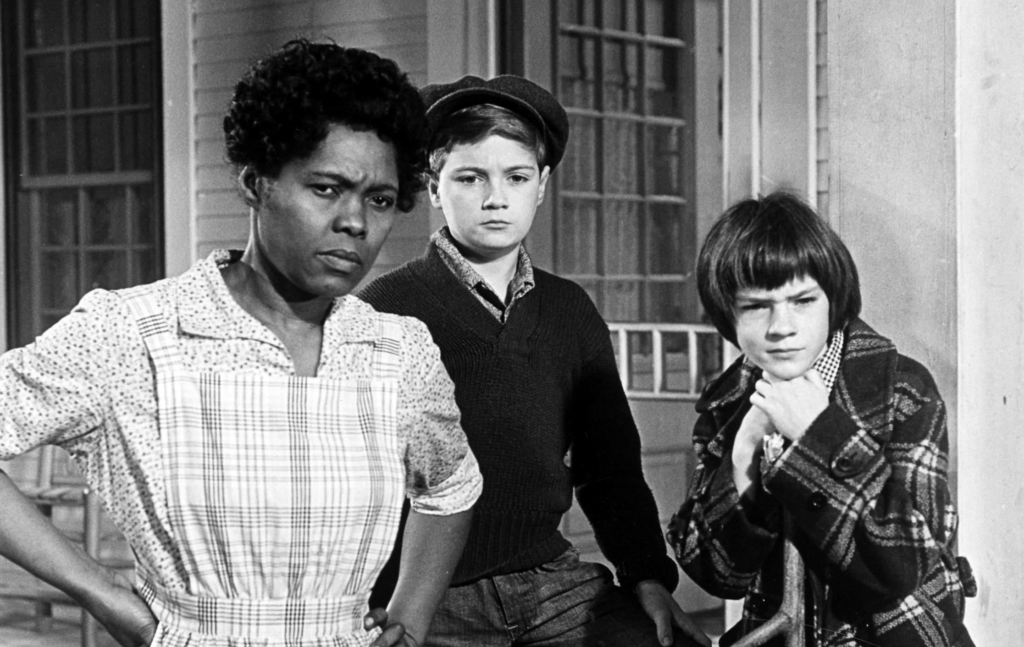
Image sourced from Britannica
Additionally, Lee demonstrates the racism in America during this time through the town’s response to Atticus agreeing to defend Tom and his subsequent trial. From the children being harassed, the attempted lynching of Tom and finally being found guilty by the jury despite overwhelming proof of his innocence, the novel demonstrates how racism affected Black people in all aspects of their lives during this time.
While the novel was set in the 1930s, Lee wrote it during the 1960s when the Civil Rights Movement was happening . The legal system continued to be discriminatory towards Black people, thus many of the racial themes that Lee explores in the novel would easily be recognisable to the public when the book was published.
The continued relevance of To Kill a Mockingbird during the 21st century can still be seen in the Black Lives Matter movement in America and ongoing racial injustices.
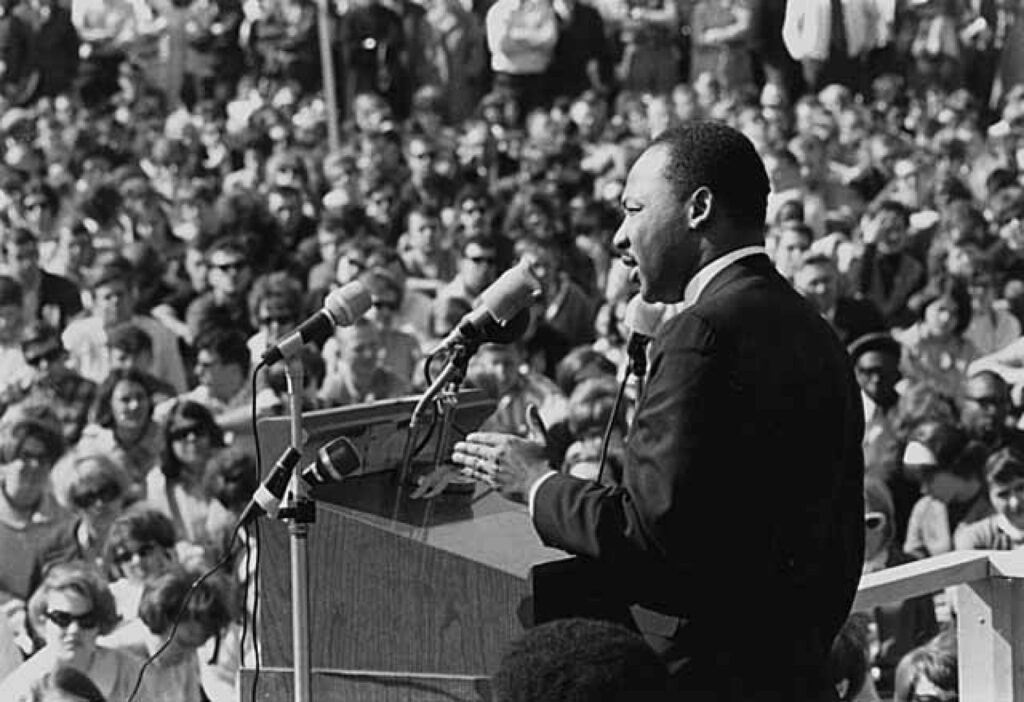
Image sourced from Minnesota Historical Society
Themes Explored in To Kill a Mockingbird
As you read through To Kill a Mockingbird, you will encounter themes such as:
- Empathy and courage
- Loss of innocence

The Complexities of Humanity
To Kill a Mockingbird explores the complexities of humanity and how both good and evil can exist at the same time within people. Told through the perspective of Scout between the ages of 6-9, readers are offered an opportunity to watch Scout mature while also learning alongside her.
Social Prejudice
Themes of social prejudice are also strong within the novel, featuring various social outcasts from Mrs Dubose who is a morphine addict, Boo Radley and the Black citizens of Maycomb.
Through these characters, Lee is able to explore the different prejudices society often holds and encourages us to be empathetic to people we may think of as unpleasant or weird due to their differences or behaviours. Instead, we are encouraged to see a different point of view and “climb into his skin and walk around in it”.
The Enduring Relevance of the Text
While To Kill a Mockingbird was set in the 1930s and written in the 1960s, many of the themes continue to remain relevant more than 50 years later. It is likely that your English classes will ask you to consider why we continue to study this book and what it teaches us about social prejudices.
While segregation may be a thing of the past, themes like racism’s impact on the justice system can still be seen in movements like Black Lives Matter. Additionally, while the book deals with racism specifically, social prejudices like how we interact with people from different backgrounds, those with a disability or LGBTQ+ people can also be examined through this book.
Events to Keep in Mind
While Tom Robinson’s case is the climax of the novel, there are various characters and events that you should keep a lookout for as well!
From the children going to the Black church, their interactions with Mrs Dubose and Boo Radley — there are various events where the children build empathy and challenge their own opinions of other citizens in the town , providing an opportunity for the readers to learn alongside them too.
How to Analyse To Kill a Mockingbird in 3 Steps
Usually, when students try to write their essay for To Kill a Mockingbird, or any other text, they’ll try to work on their thesis first when responding to an essay question — however, we recommend starting with your analysis!
Doing this will allow you to expand your knowledge of the text before thoroughly answering anything about it. Once you’ve analysed your text, then you can draw ideas from it and properly build your thesis.
We’re going to walk you through writing up an essay analysis for To Kill a Mockingbird in three simple steps!
Step 1: Choose your example
When picking an example ensure that you are able to identify a technique in the text.
Here, we have chosen to look at Atticus’s statement to the Court and jury at Tom Robinson’s trial:
“We know all men are not created equal in the sense some people would have us believe – some people are smarter than others, some people have more opportunity because they’re born with it, some men make more money than others, some ladies make better cakes than others… But there is one way in this country in which all men have been created equal… That institution, gentlemen, is a court.”
This is quite a long quote from To Kill a Mockingbird, so remember when you’re actually writing up your analysis for your essay, you don’t actually need to include the complete quote — just excerpts.
We’ve got a list of 50 quotes that you should check out from To Kill a Mockingbird!
Step 2: Identify your technique(s)
Ensure that the technique you choose for your quote supports your analysis or helps you to build your argument.
To enhance your response, you want to discuss techniques that have a lot more depth — you should keep an eye out for any literary techniques such as metaphors, similes and motifs!
For the above quote, there is repetition, cumulative listing, inclusive language and allusion.
Step 3: Write the analysis
When writing the analysis, focus on the effect of the technique and how it supports your argument. In this case, we are going to analyse how the quote addresses the theme of racial prejudices.
The opening of “we know all men are not created equal” subverts the American declaration of independence , as Atticus utilises cumulative listing to demonstrate all the ways in which men and women are not equal.
However, he also reminds the jury during this trial that the law is a “way in this country in which all men have been created equal”, alluding to the American Declaration of Independence and the core values of the nation . Analysis for this quote may look like:
Atticus, aware that the jury is likely to find Tom Robinson guilty despite strong evidence of his innocence due to the racial prejudices the White jury is likely to hold tries to challenge this t hrough the inclusive language of in “we know all men are not created equal”, Atticus presents the jury and the defence as being on the same side. Furthermore, the allusion to the core American values when he states “in this country there is one way all men have been created equal”, creates an appeal to both the jury’s sense of justice and core American values.
Need to write a Feature Article on ‘To Kill a Mockingbird’? Look no further than this incredible in-depth guide to help you ace your writing!
Need some help analysing other texts?
Check out other texts we’ve created guides for below:
- All the Light We Cannot See
- Lord of the Flies
- The Meursault Investigation
- In Cold Blood
- Pride and Prejudice
- Jasper Jones
- Romeo and Juliet
Read also: how to write a feature article for English !
Are you looking for some extra help with your essay analysis of To Kill a Mockingbird?
We have an incredible team of qce tutors and mentors.
We can help you master your essay analysis of To Kill a Mockingbird by taking you through the summary, key characters and themes. We’ll also help you ace your upcoming English assessments with personalised lessons conducted one-on-one in your home or online!
We’ve supported over 8,000 students over the last 11 years , and on average our students score mark improvements of over 20%!
To find out more and get started with an inspirational QCE tutor and mentor, get in touch today or give us a ring on 1300 267 888!
Tiffany Fong is currently completing a double degree in Media and Communications with Law at Macquarie University. She currently contributes to the university zine, Grapeshot where she enjoys writing feature articles, commentary on current affairs or whatever weird interest that has taken over her mind during that month. During her spare time, Tiffany enjoys reading, writing, taking care of her plants or cuddling with her two dogs.
- Topics: ✏️ English , ✍️ Learn
Related Articles
The extensive guide to analysing shakespeare’s ‘the tempest’: summary, context, characters & themes, the definitive guide to analysing shakespeare’s ‘romeo and juliet’: summary, context, themes & characters, the ultimate guide to analysing lord of the flies for english: summary, themes & characters, 45,861 students have a head start....
Get exclusive study content & advice from our team of experts delivered weekly to your inbox!

Looking for English Support?
Discover how we can help you!

We provide services in
Home — Essay Samples — Literature — To Kill a Mockingbird — To Kill A Mockingbird Setting Analysis
To Kill a Mockingbird Setting Analysis
- Categories: Harper Lee To Kill a Mockingbird
About this sample

Words: 1013 |
Published: Mar 5, 2024
Words: 1013 | Pages: 2 | 6 min read

Cite this Essay
To export a reference to this article please select a referencing style below:
Let us write you an essay from scratch
- 450+ experts on 30 subjects ready to help
- Custom essay delivered in as few as 3 hours
Get high-quality help

Verified writer
- Expert in: Literature

+ 120 experts online
By clicking “Check Writers’ Offers”, you agree to our terms of service and privacy policy . We’ll occasionally send you promo and account related email
No need to pay just yet!
Related Essays
1 pages / 620 words
6.5 pages / 2852 words
4 pages / 1728 words
2.5 pages / 1208 words
Remember! This is just a sample.
You can get your custom paper by one of our expert writers.
121 writers online
Still can’t find what you need?
Browse our vast selection of original essay samples, each expertly formatted and styled
Related Essays on To Kill a Mockingbird
The novel provides a poignant portrayal of the different forms of discrimination experienced by various characters, including racial, social, and gender-based prejudices. In the current context, the themes depicted in the novel [...]
Boo Radley, a mysterious and reclusive figure in Harper Lee's novel "To Kill a Mockingbird," is a character who fascinates readers and plays a crucial role in the development of the story. Despite his absence for most of the [...]
In Harper Lee's classic novel "To Kill a Mockingbird," Atticus Finch really shows what it means to be brave when times are tough. He defends a black man, Tom Robinson, who's accused of raping a white woman in the racially [...]
"To Kill a Mockingbird" by Harper Lee is a timeless classic that has been appreciated by many across generations. Published in 1960, it tells the story of a young girl named Scout Finch who grows up in the fictional town of [...]
“To Kill a Mockingbird” by Harper Lee is one of the greatest works of American literature of all time. It has been reprinted again and again, and is a staple in almost any writing or history class. There are a number of reasons [...]
In Harper Lee’s To Kill A Mockingbird, she uses methods of characterisation such as action/incident, emotional setting, reaction, and thoughts to convey the theme of ‘Good and Evil can coexist’. To Kill A Mockingbird is a novel [...]
Related Topics
By clicking “Send”, you agree to our Terms of service and Privacy statement . We will occasionally send you account related emails.
Where do you want us to send this sample?
By clicking “Continue”, you agree to our terms of service and privacy policy.
Be careful. This essay is not unique
This essay was donated by a student and is likely to have been used and submitted before
Download this Sample
Free samples may contain mistakes and not unique parts
Sorry, we could not paraphrase this essay. Our professional writers can rewrite it and get you a unique paper.
Please check your inbox.
We can write you a custom essay that will follow your exact instructions and meet the deadlines. Let's fix your grades together!
Get Your Personalized Essay in 3 Hours or Less!
We use cookies to personalyze your web-site experience. By continuing we’ll assume you board with our cookie policy .
- Instructions Followed To The Letter
- Deadlines Met At Every Stage
- Unique And Plagiarism Free

- Ask LitCharts AI
- Discussion Question Generator
- Essay Prompt Generator
- Quiz Question Generator

- Literature Guides
- Poetry Guides
- Shakespeare Translations
- Literary Terms
To Kill a Mockingbird
Welcome to the LitCharts study guide on Harper Lee's To Kill a Mockingbird . Created by the original team behind SparkNotes, LitCharts are the world's best literature guides.
To Kill a Mockingbird: Introduction
To kill a mockingbird: plot summary, to kill a mockingbird: detailed summary & analysis, to kill a mockingbird: themes, to kill a mockingbird: quotes, to kill a mockingbird: characters, to kill a mockingbird: symbols, to kill a mockingbird: literary devices, to kill a mockingbird: theme wheel, brief biography of harper lee.
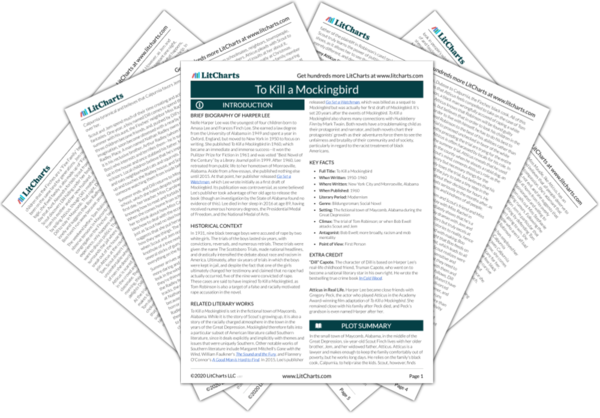
Historical Context of To Kill a Mockingbird
Other books related to to kill a mockingbird.
- Full Title: To Kill a Mockingbird
- When Written: 1950-1960
- Where Written: New York City and Monroeville, Alabama
- When Published: 1960
- Literary Period: Modernism
- Genre: Bildungsroman; Social Novel
- Setting: The fictional town of Maycomb, Alabama during the Great Depression
- Climax: The trial of Tom Robinson; or when Bob Ewell attacks Scout and Jem
- Antagonist: Bob Ewell; more broadly, racism and mob mentality
- Point of View: First Person
Extra Credit for To Kill a Mockingbird
“Dill” Capote. The character of Dill is based on Harper Lee’s real-life childhood friend, Truman Capote, who went on to become a national literary star in his own right. He wrote the bestselling true crime book In Cold Blood .
Atticus in Real Life. Harper Lee became close friends with Gregory Peck, the actor who played Atticus in the Academy Award-winning film adaptation of To Kill a Mockingbird . She remained close with his family after Peck died, and Peck’s grandson is even named Harper after her.

- Quizzes, saving guides, requests, plus so much more.

IMAGES
VIDEO
COMMENTS
To Kill a Mockingbird Essay Topic Examples. You can analyze its themes in argumentative essays, compare and contrast characters or themes, describe the book's settings, persuade readers about certain points, or narrate personal experiences related to the novel's themes.
In To Kill a Mockingbird, children live in an inventive world where mysteries abound but little exists to actually cause them harm. Scout and Jem spend much of their time inventing stories about their reclusive neighbor Boo Radley, gleefully scaring themselves before rushing to the secure, calming presence of their father, Atticus.
To Kill a Mockingbird tells the story of the young narrator’s passage from innocence to experience when her father confronts the racist justice system of the rural, Depression-era South. In witnessing the trial of Tom Robinson, a Black man unfairly accused of rape, Scout, the narrator, gains insight into her town, her family, and herself.
“To Kill a Mockingbird” is a profound exploration of racial injustice in the American South during the 1930s. The novel portrays systemic racism as an ingrained and pervasive element of Southern society, manifesting in both overt actions and subtle social norms.
We can help you master your essay analysis of To Kill a Mockingbird by taking you through the summary, key characters and themes. We’ll also help you ace your upcoming English assessments with personalised lessons conducted one-on-one in your home or online!
Analysis: To Kill a Mockingbird. Although Harper Lee set her novel in a very isolated locale, which she calls Maycomb, in an era when her notion of crossing racial and social boundaries...
In this essay, we will delve into the significance of the setting in To Kill A Mockingbird, examining how the historical, social, and geographical context of Maycomb contributes to the development of the story and the characters.
Analyze the trial scene and its relationship to the rest of the novel. To Kill a Mockingbird explores the questions of innocence and harsh experience, good and evil, from several different angles.
The best study guide to To Kill a Mockingbird on the planet, from the creators of SparkNotes. Get the summaries, analysis, and quotes you need.
Can you explain the proper structure for an analytical essay, using To Kill A Mockingbird as an example? Why is Atticus respected in Maycomb despite open criticism?